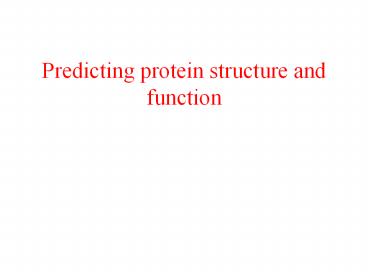Predicting protein structure and function - PowerPoint PPT Presentation
Title:
Predicting protein structure and function
Description:
Not all proteins are enzymes: ... Burried and Edge strands. Parallel -sheet. Anti-parallel -sheet. Periodicity patterns. Burried -strand. Edge -strand -helix ... – PowerPoint PPT presentation
Number of Views:43
Avg rating:3.0/5.0
Title: Predicting protein structure and function
1
Predicting protein structure and function
2
Protein function
Genome/DNA Transcriptome/mRNA Proteome Metabolo
me Physiome
Transcription factors
Ribosomal proteins Chaperonins
Enzymes
3
Protein function
Not all proteins are enzymes ?-crystallin eye
lens protein needs to stay stable and
transparent for a lifetime (very little turnover
in the eye lens)
4
What can happen to protein function through
evolution
- Proteins can have multiple functions (and
sometimes many -- Ig). - Enzyme function is defined by specificity and
activity - Through evolution
- Function and specificity can stay the same
- Function stays same but specificity changes
- Change to some similar function (e.g. somewhere
else in metabolic system) - Change to completely new function
5
How to arrive at a given function
- Divergent evolution homologous proteins
proteins have same structure and same-ish
function - Convergent evolution analogous proteins
different structure but same function - Question can homologous proteins change
structure (and function)?
6
How to evolve
- Important distinction
- Orthologues homologous proteins in different
species (all deriving from same ancestor) - Paralogues homologous proteins in same species
(internal gene duplication) - In practice to recognise orthology,
bi-directional best hit is used in conjunction
with database search program
7
How to evolve
- By addition of domains (at either end of protein
sequence) Lesk book page 108 - Often through gene duplication followed by
divergence
8
Structural domain organisation can be nasty
Pyruvate kinase Phosphotransferase
b barrel regulatory domain a/b barrel catalytic
substrate binding domain a/b nucleotide binding
domain
1 continuous 2 discontinuous domains
9
- The DEATH Domain
- Present in a variety of Eukaryotic proteins
involved with cell death. - Six helices enclose a tightly packed hydrophobic
core. - Some DEATH domains form homotypic and
heterotypic dimers.
http//www.mshri.on.ca/pawson
10
How to predict function
- Sequence information Homology searching
- Sequence-structure information Fold recognition
(Threading) - Structure-structure information structure
superpositioning
11
Flavodoxin fold
5(??) fold
12
Rules of thumb when looking at a multiple
alignment (MA)
- Hydrophobic residues are internal
- Gly (Thr, Ser) in loops
- MA hydrophobic block -gt internal ?-strand
- MA alternating (1-1) hydrophobic/hydrophilic gt
edge ?-strand - MA alternating 2-2 (or 3-1) periodicity gt
?-helix - MA gaps in loops
- MA Conserved column gt functional? gt active
site
13
Rules of thumb when looking at a multiple
alignment (MA)
- Active site residues are together in 3D structure
- Helices often cover up core of strands
- Helices less extended than strands gt more
residues to cross protein - ?-?-? motif is right-handed in gt95 of cases
(with parallel strands) - MA inconsistent alignment columns and match
errors! - Secondary structures have local anomalies, e.g.
?-bulges
14
Burried and Edge strands
Parallel ?-sheet
Anti-parallel ?-sheet
15
Periodicity patterns
Burried ?-strand Edge ?-strand ?-helix































